Full text
PDF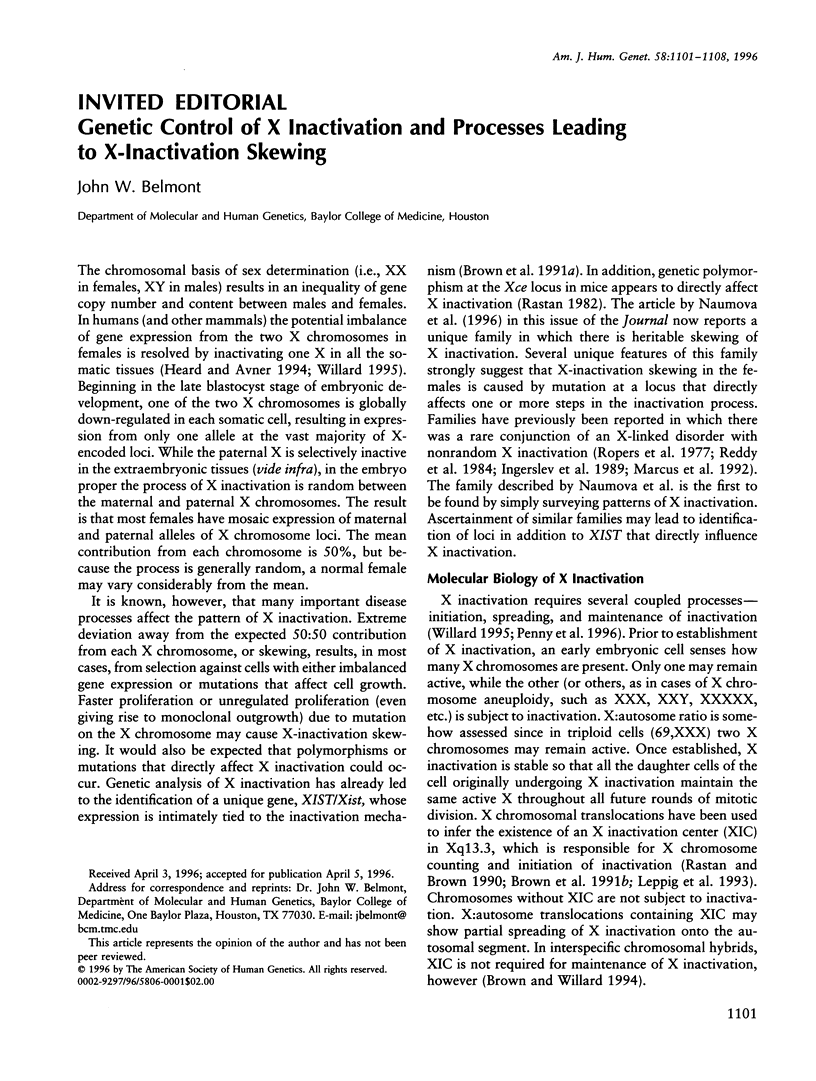
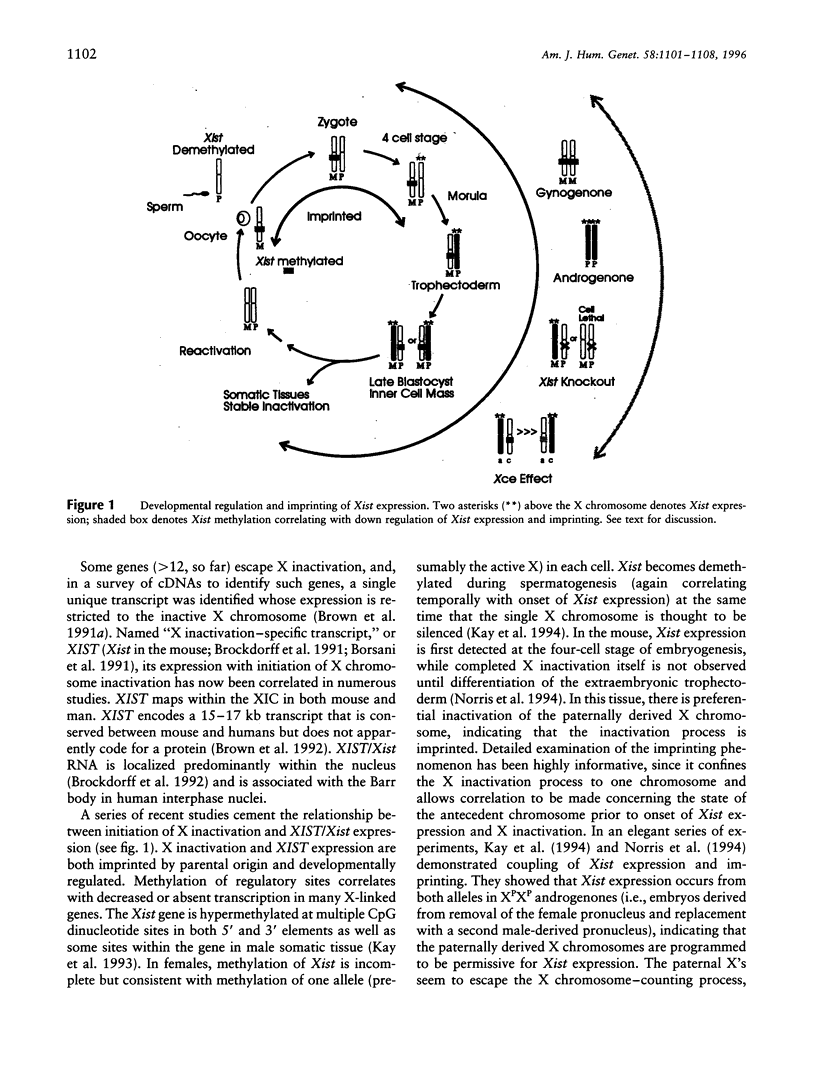
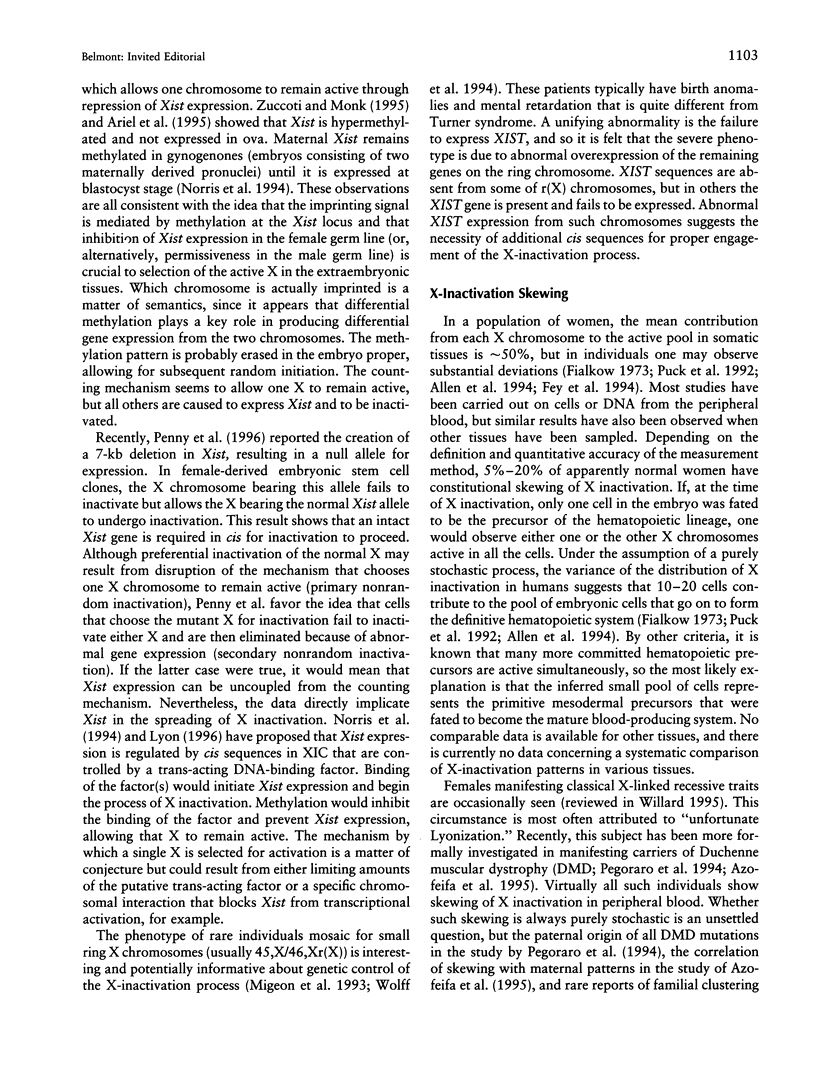
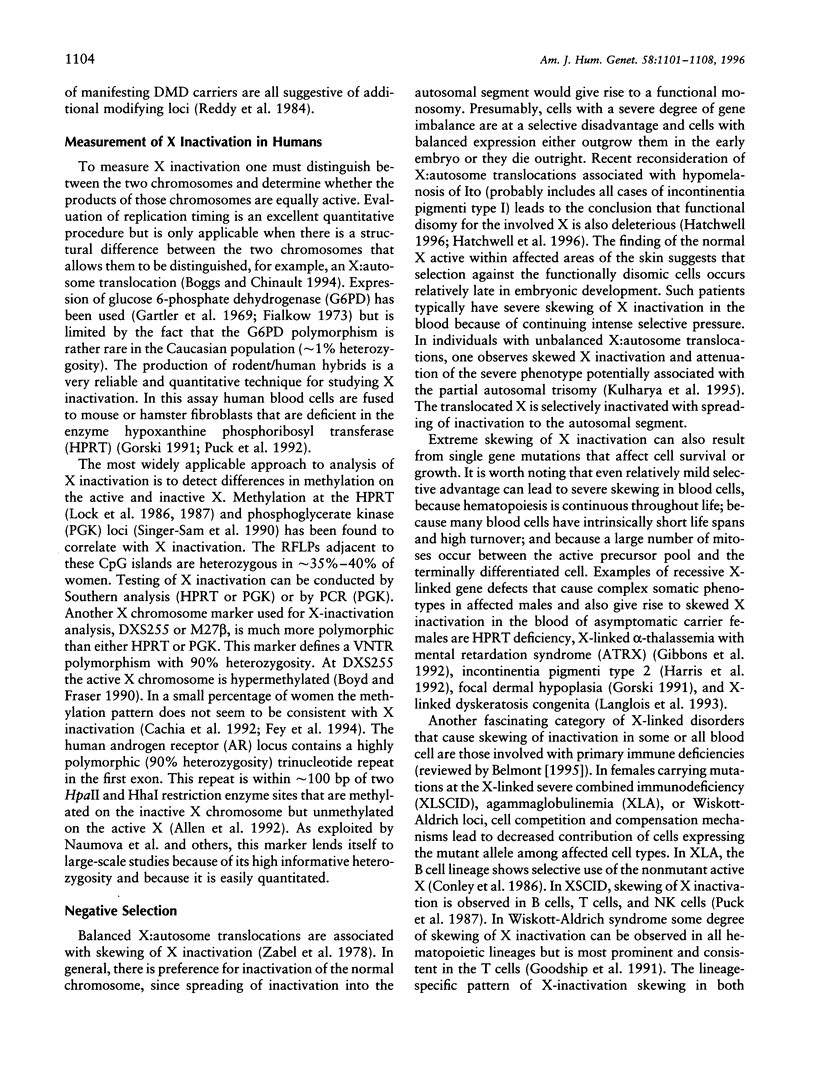
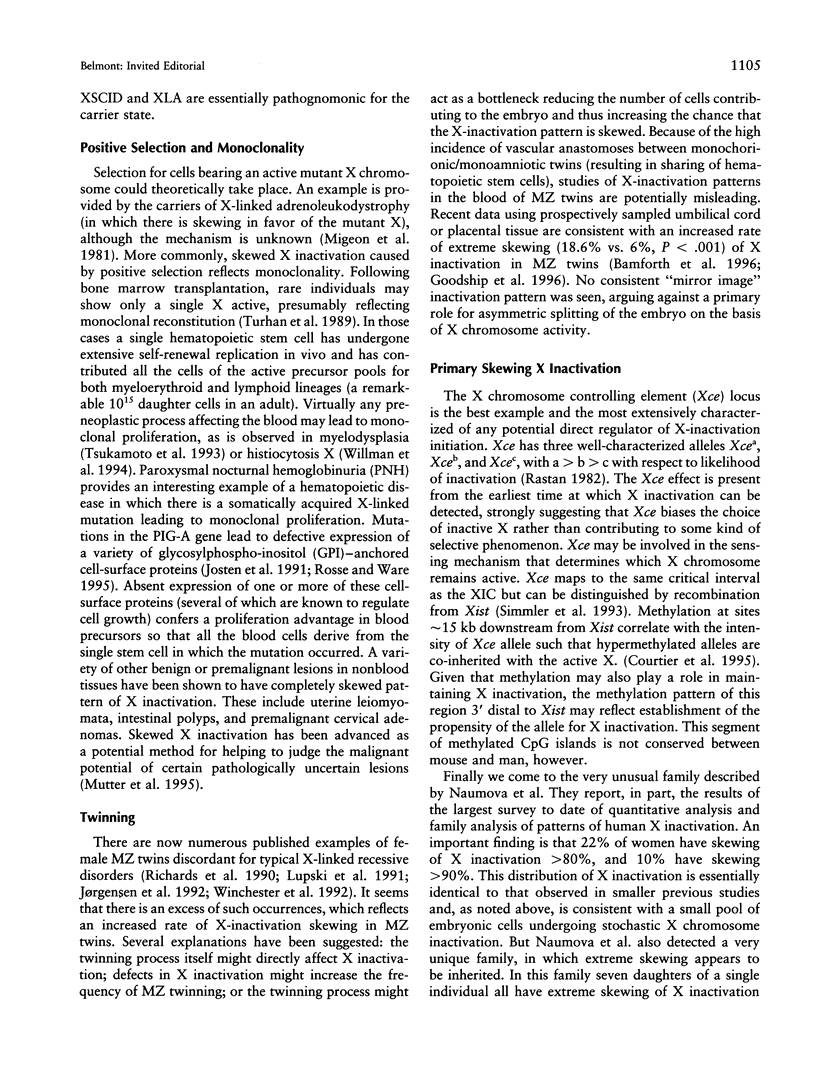
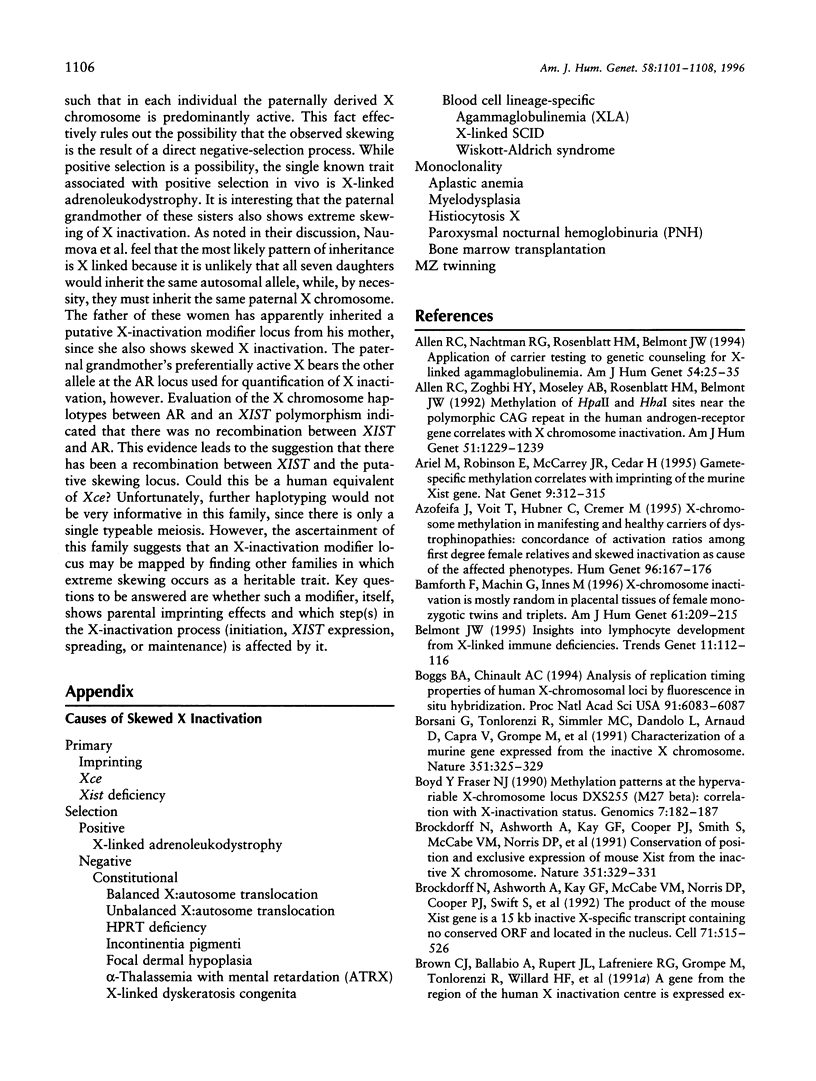
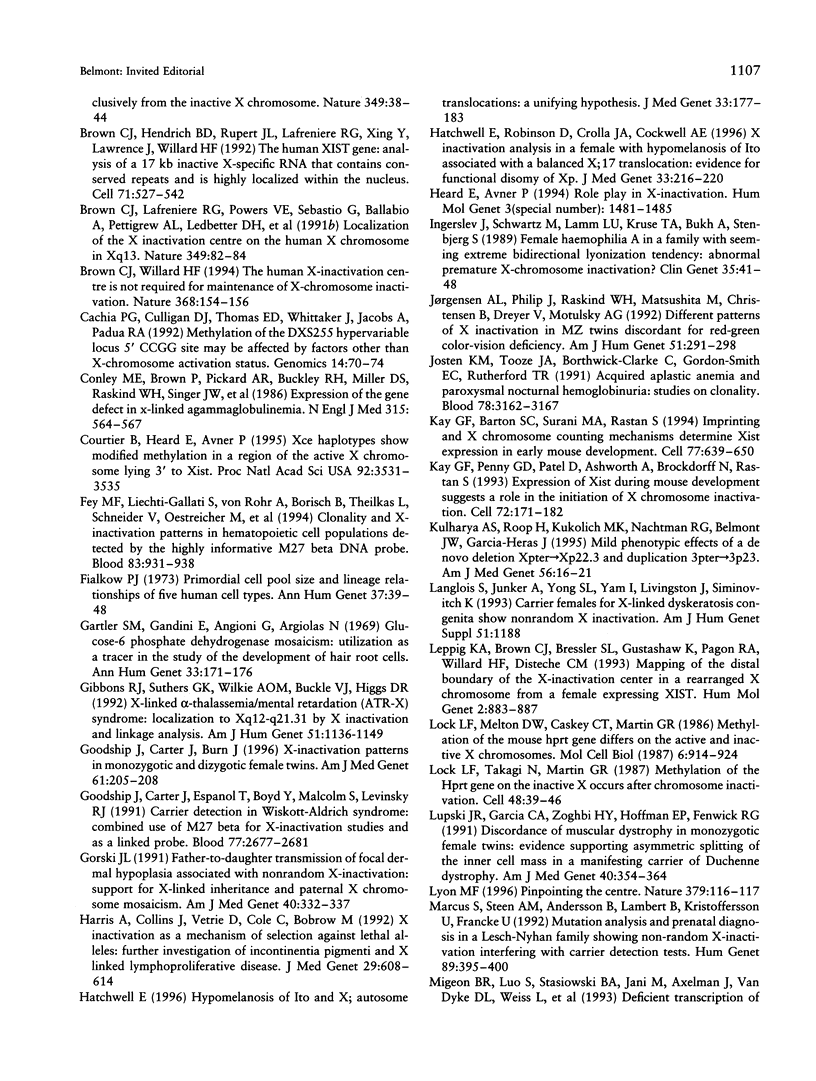
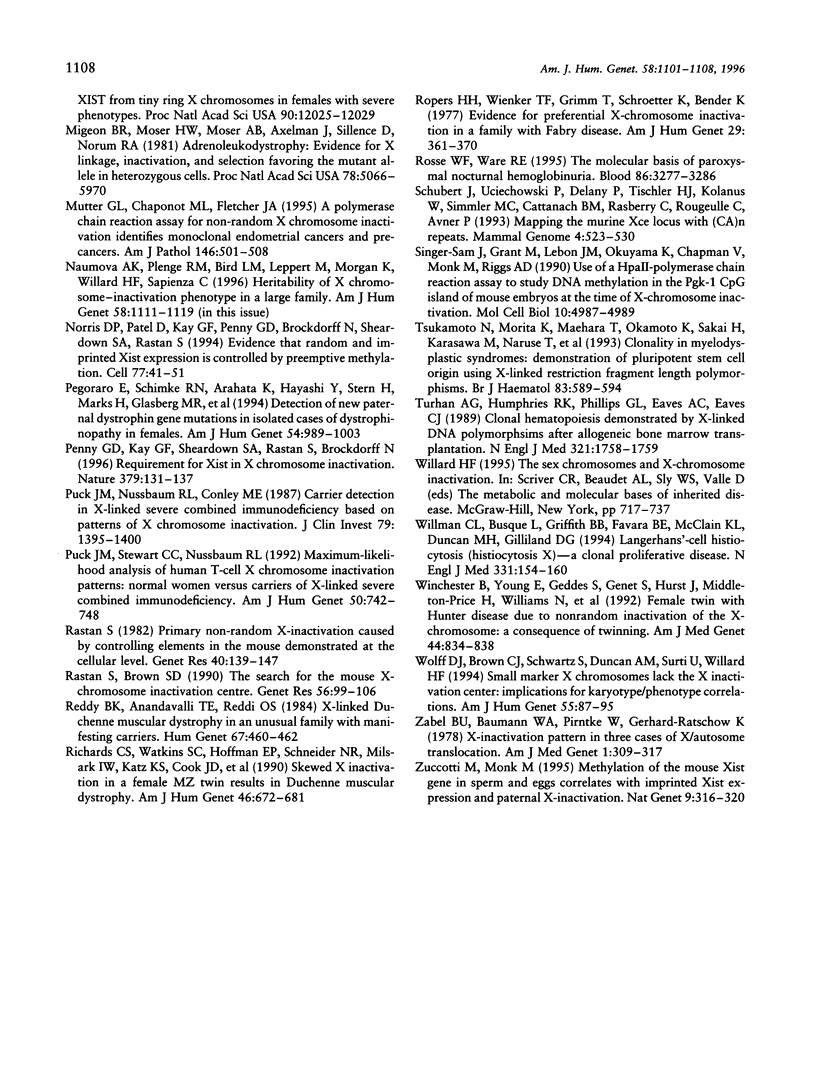
Selected References
These references are in PubMed. This may not be the complete list of references from this article.
- Allen R. C., Nachtman R. G., Rosenblatt H. M., Belmont J. W. Application of carrier testing to genetic counseling for X-linked agammaglobulinemia. Am J Hum Genet. 1994 Jan;54(1):25–35. [PMC free article] [PubMed] [Google Scholar]
- Allen R. C., Zoghbi H. Y., Moseley A. B., Rosenblatt H. M., Belmont J. W. Methylation of HpaII and HhaI sites near the polymorphic CAG repeat in the human androgen-receptor gene correlates with X chromosome inactivation. Am J Hum Genet. 1992 Dec;51(6):1229–1239. [PMC free article] [PubMed] [Google Scholar]
- Ariel M., Robinson E., McCarrey J. R., Cedar H. Gamete-specific methylation correlates with imprinting of the murine Xist gene. Nat Genet. 1995 Mar;9(3):312–315. doi: 10.1038/ng0395-312. [DOI] [PubMed] [Google Scholar]
- Azofeifa J., Voit T., Hübner C., Cremer M. X-chromosome methylation in manifesting and healthy carriers of dystrophinopathies: concordance of activation ratios among first degree female relatives and skewed inactivation as cause of the affected phenotypes. Hum Genet. 1995 Aug;96(2):167–176. doi: 10.1007/BF00207374. [DOI] [PubMed] [Google Scholar]
- Bamforth F., Machin G., Innes M. X-chromosome inactivation is mostly random in placental tissues of female monozygotic twins and triplets. Am J Med Genet. 1996 Jan 22;61(3):209–215. doi: 10.1002/(SICI)1096-8628(19960122)61:3<209::AID-AJMG4>3.0.CO;2-P. [DOI] [PubMed] [Google Scholar]
- Belmont J. W. Insights into lymphocyte development from X-linked immune deficiencies. Trends Genet. 1995 Mar;11(3):112–116. doi: 10.1016/S0168-9525(00)89012-5. [DOI] [PubMed] [Google Scholar]
- Boggs B. A., Chinault A. C. Analysis of replication timing properties of human X-chromosomal loci by fluorescence in situ hybridization. Proc Natl Acad Sci U S A. 1994 Jun 21;91(13):6083–6087. doi: 10.1073/pnas.91.13.6083. [DOI] [PMC free article] [PubMed] [Google Scholar]
- Borsani G., Tonlorenzi R., Simmler M. C., Dandolo L., Arnaud D., Capra V., Grompe M., Pizzuti A., Muzny D., Lawrence C. Characterization of a murine gene expressed from the inactive X chromosome. Nature. 1991 May 23;351(6324):325–329. doi: 10.1038/351325a0. [DOI] [PubMed] [Google Scholar]
- Boyd Y., Fraser N. J. Methylation patterns at the hypervariable X-chromosome locus DXS255 (M27 beta): correlation with X-inactivation status. Genomics. 1990 Jun;7(2):182–187. doi: 10.1016/0888-7543(90)90539-7. [DOI] [PubMed] [Google Scholar]
- Brockdorff N., Ashworth A., Kay G. F., Cooper P., Smith S., McCabe V. M., Norris D. P., Penny G. D., Patel D., Rastan S. Conservation of position and exclusive expression of mouse Xist from the inactive X chromosome. Nature. 1991 May 23;351(6324):329–331. doi: 10.1038/351329a0. [DOI] [PubMed] [Google Scholar]
- Brockdorff N., Ashworth A., Kay G. F., McCabe V. M., Norris D. P., Cooper P. J., Swift S., Rastan S. The product of the mouse Xist gene is a 15 kb inactive X-specific transcript containing no conserved ORF and located in the nucleus. Cell. 1992 Oct 30;71(3):515–526. doi: 10.1016/0092-8674(92)90519-i. [DOI] [PubMed] [Google Scholar]
- Brown C. J., Hendrich B. D., Rupert J. L., Lafrenière R. G., Xing Y., Lawrence J., Willard H. F. The human XIST gene: analysis of a 17 kb inactive X-specific RNA that contains conserved repeats and is highly localized within the nucleus. Cell. 1992 Oct 30;71(3):527–542. doi: 10.1016/0092-8674(92)90520-m. [DOI] [PubMed] [Google Scholar]
- Brown C. J., Lafreniere R. G., Powers V. E., Sebastio G., Ballabio A., Pettigrew A. L., Ledbetter D. H., Levy E., Craig I. W., Willard H. F. Localization of the X inactivation centre on the human X chromosome in Xq13. Nature. 1991 Jan 3;349(6304):82–84. doi: 10.1038/349082a0. [DOI] [PubMed] [Google Scholar]
- Brown C. J., Willard H. F. The human X-inactivation centre is not required for maintenance of X-chromosome inactivation. Nature. 1994 Mar 10;368(6467):154–156. doi: 10.1038/368154a0. [DOI] [PubMed] [Google Scholar]
- Cachia P. G., Culligan D. J., Thomas E. D., Whittaker J., Jacobs A., Padua R. A. Methylation of the DXS255 hypervariable locus 5' CCGG site may be affected by factors other than X-chromosome activation status. Genomics. 1992 Sep;14(1):70–74. doi: 10.1016/s0888-7543(05)80285-x. [DOI] [PubMed] [Google Scholar]
- Conley M. E., Brown P., Pickard A. R., Buckley R. H., Miller D. S., Raskind W. H., Singer J. W., Fialkow P. J. Expression of the gene defect in X-linked agammaglobulinemia. N Engl J Med. 1986 Aug 28;315(9):564–567. doi: 10.1056/NEJM198608283150907. [DOI] [PubMed] [Google Scholar]
- Courtier B., Heard E., Avner P. Xce haplotypes show modified methylation in a region of the active X chromosome lying 3' to Xist. Proc Natl Acad Sci U S A. 1995 Apr 11;92(8):3531–3535. doi: 10.1073/pnas.92.8.3531. [DOI] [PMC free article] [PubMed] [Google Scholar]
- Fey M. F., Liechti-Gallati S., von Rohr A., Borisch B., Theilkäs L., Schneider V., Oestreicher M., Nagel S., Ziemiecki A., Tobler A. Clonality and X-inactivation patterns in hematopoietic cell populations detected by the highly informative M27 beta DNA probe. Blood. 1994 Feb 15;83(4):931–938. [PubMed] [Google Scholar]
- Fialkow P. J. Primordial cell pool size and lineage relationships of five human cell types. Ann Hum Genet. 1973 Jul;37(1):39–48. doi: 10.1111/j.1469-1809.1973.tb01813.x. [DOI] [PubMed] [Google Scholar]
- Gartler S. M., Gandini E., Angioni G., Argiolas N. Glucose-6 phosphate dehydrogenase mosaicism: utilization as a tracer in the study of the development of hair root cells. Ann Hum Genet. 1969 Oct;33(2):171–176. doi: 10.1111/j.1469-1809.1969.tb01642.x. [DOI] [PubMed] [Google Scholar]
- Gibbons R. J., Suthers G. K., Wilkie A. O., Buckle V. J., Higgs D. R. X-linked alpha-thalassemia/mental retardation (ATR-X) syndrome: localization to Xq12-q21.31 by X inactivation and linkage analysis. Am J Hum Genet. 1992 Nov;51(5):1136–1149. [PMC free article] [PubMed] [Google Scholar]
- Goodship J., Carter J., Burn J. X-inactivation patterns in monozygotic and dizygotic female twins. Am J Med Genet. 1996 Jan 22;61(3):205–208. doi: 10.1002/(SICI)1096-8628(19960122)61:3<205::AID-AJMG3>3.0.CO;2-T. [DOI] [PubMed] [Google Scholar]
- Goodship J., Carter J., Espanol T., Boyd Y., Malcolm S., Levinsky R. J. Carrier detection in Wiskott-Aldrich syndrome: combined use of M27 beta for X-inactivation studies and as a linked probe. Blood. 1991 Jun 15;77(12):2677–2681. [PubMed] [Google Scholar]
- Gorski J. L. Father-to-daughter transmission of focal dermal hypoplasia associated with nonrandom X-inactivation: support for X-linked inheritance and paternal X chromosome mosaicism. Am J Med Genet. 1991 Sep 1;40(3):332–337. doi: 10.1002/ajmg.1320400317. [DOI] [PubMed] [Google Scholar]
- Harris A., Collins J., Vetrie D., Cole C., Bobrow M. X inactivation as a mechanism of selection against lethal alleles: further investigation of incontinentia pigmenti and X linked lymphoproliferative disease. J Med Genet. 1992 Sep;29(9):608–614. doi: 10.1136/jmg.29.9.608. [DOI] [PMC free article] [PubMed] [Google Scholar]
- Hatchwell E. Hypomelanosis of Ito and X;autosome translocations: a unifying hypothesis. J Med Genet. 1996 Mar;33(3):177–183. doi: 10.1136/jmg.33.3.177. [DOI] [PMC free article] [PubMed] [Google Scholar]
- Hatchwell E., Robinson D., Crolla J. A., Cockwell A. E. X inactivation analysis in a female with hypomelanosis of Ito associated with a balanced X;17 translocation: evidence for functional disomy of Xp. J Med Genet. 1996 Mar;33(3):216–220. doi: 10.1136/jmg.33.3.216. [DOI] [PMC free article] [PubMed] [Google Scholar]
- Heard E., Avner P. Role play in X-inactivation. Hum Mol Genet. 1994;3(Spec No):1481–1485. doi: 10.1093/hmg/3.suppl_1.1481. [DOI] [PubMed] [Google Scholar]
- Ingerslev J., Schwartz M., Lamm L. U., Kruse T. A., Bukh A., Stenbjerg S. Female haemophilia A in a family with seeming extreme bidirectional lyonization tendency: abnormal premature X-chromosome inactivation? Clin Genet. 1989 Jan;35(1):41–48. doi: 10.1111/j.1399-0004.1989.tb02903.x. [DOI] [PubMed] [Google Scholar]
- Josten K. M., Tooze J. A., Borthwick-Clarke C., Gordon-Smith E. C., Rutherford T. R. Acquired aplastic anemia and paroxysmal nocturnal hemoglobinuria: studies on clonality. Blood. 1991 Dec 15;78(12):3162–3167. [PubMed] [Google Scholar]
- Jørgensen A. L., Philip J., Raskind W. H., Matsushita M., Christensen B., Dreyer V., Motulsky A. G. Different patterns of X inactivation in MZ twins discordant for red-green color-vision deficiency. Am J Hum Genet. 1992 Aug;51(2):291–298. [PMC free article] [PubMed] [Google Scholar]
- Kaladhar Reddy B., Anandavalli T. E., Reddi O. S. X-linked Duchenne muscular dystrophy in an unusual family with manifesting carriers. Hum Genet. 1984;67(4):460–462. doi: 10.1007/BF00291412. [DOI] [PubMed] [Google Scholar]
- Kay G. F., Barton S. C., Surani M. A., Rastan S. Imprinting and X chromosome counting mechanisms determine Xist expression in early mouse development. Cell. 1994 Jun 3;77(5):639–650. doi: 10.1016/0092-8674(94)90049-3. [DOI] [PubMed] [Google Scholar]
- Kay G. F., Penny G. D., Patel D., Ashworth A., Brockdorff N., Rastan S. Expression of Xist during mouse development suggests a role in the initiation of X chromosome inactivation. Cell. 1993 Jan 29;72(2):171–182. doi: 10.1016/0092-8674(93)90658-d. [DOI] [PubMed] [Google Scholar]
- Kulharya A. S., Roop H., Kukolich M. K., Nachtman R. G., Belmont J. W., Garcia-Heras J. Mild phenotypic effects of a de novo deletion Xpter-->Xp22.3 and duplication 3pter-->3p23. Am J Med Genet. 1995 Mar 13;56(1):16–21. doi: 10.1002/ajmg.1320560106. [DOI] [PubMed] [Google Scholar]
- Leppig K. A., Brown C. J., Bressler S. L., Gustashaw K., Pagon R. A., Willard H. F., Disteche C. M. Mapping of the distal boundary of the X-inactivation center in a rearranged X chromosome from a female expressing XIST. Hum Mol Genet. 1993 Jul;2(7):883–887. doi: 10.1093/hmg/2.7.883. [DOI] [PubMed] [Google Scholar]
- Lock L. F., Melton D. W., Caskey C. T., Martin G. R. Methylation of the mouse hprt gene differs on the active and inactive X chromosomes. Mol Cell Biol. 1986 Mar;6(3):914–924. doi: 10.1128/mcb.6.3.914. [DOI] [PMC free article] [PubMed] [Google Scholar]
- Lock L. F., Takagi N., Martin G. R. Methylation of the Hprt gene on the inactive X occurs after chromosome inactivation. Cell. 1987 Jan 16;48(1):39–46. doi: 10.1016/0092-8674(87)90353-9. [DOI] [PubMed] [Google Scholar]
- Lupski J. R., Garcia C. A., Zoghbi H. Y., Hoffman E. P., Fenwick R. G. Discordance of muscular dystrophy in monozygotic female twins: evidence supporting asymmetric splitting of the inner cell mass in a manifesting carrier of Duchenne dystrophy. Am J Med Genet. 1991 Sep 1;40(3):354–364. doi: 10.1002/ajmg.1320400323. [DOI] [PubMed] [Google Scholar]
- Lyon M. F. X-chromosome inactivation. Pinpointing the centre. Nature. 1996 Jan 11;379(6561):116–117. doi: 10.1038/379116a0. [DOI] [PubMed] [Google Scholar]
- Marcus S., Steen A. M., Andersson B., Lambert B., Kristoffersson U., Francke U. Mutation analysis and prenatal diagnosis in a Lesch-Nyhan family showing non-random X-inactivation interfering with carrier detection tests. Hum Genet. 1992 Jun;89(4):395–400. doi: 10.1007/BF00194310. [DOI] [PubMed] [Google Scholar]
- Migeon B. R., Moser H. W., Moser A. B., Axelman J., Sillence D., Norum R. A. Adrenoleukodystrophy: evidence for X linkage, inactivation, and selection favoring the mutant allele in heterozygous cells. Proc Natl Acad Sci U S A. 1981 Aug;78(8):5066–5070. doi: 10.1073/pnas.78.8.5066. [DOI] [PMC free article] [PubMed] [Google Scholar]
- Mutter G. L., Chaponot M. L., Fletcher J. A. A polymerase chain reaction assay for non-random X chromosome inactivation identifies monoclonal endometrial cancers and precancers. Am J Pathol. 1995 Feb;146(2):501–508. [PMC free article] [PubMed] [Google Scholar]
- Naumova A. K., Plenge R. M., Bird L. M., Leppert M., Morgan K., Willard H. F., Sapienza C. Heritability of X chromosome--inactivation phenotype in a large family. Am J Hum Genet. 1996 Jun;58(6):1111–1119. [PMC free article] [PubMed] [Google Scholar]
- Norris D. P., Patel D., Kay G. F., Penny G. D., Brockdorff N., Sheardown S. A., Rastan S. Evidence that random and imprinted Xist expression is controlled by preemptive methylation. Cell. 1994 Apr 8;77(1):41–51. doi: 10.1016/0092-8674(94)90233-x. [DOI] [PubMed] [Google Scholar]
- Pegoraro E., Schimke R. N., Arahata K., Hayashi Y., Stern H., Marks H., Glasberg M. R., Carroll J. E., Taber J. W., Wessel H. B. Detection of new paternal dystrophin gene mutations in isolated cases of dystrophinopathy in females. Am J Hum Genet. 1994 Jun;54(6):989–1003. [PMC free article] [PubMed] [Google Scholar]
- Penny G. D., Kay G. F., Sheardown S. A., Rastan S., Brockdorff N. Requirement for Xist in X chromosome inactivation. Nature. 1996 Jan 11;379(6561):131–137. doi: 10.1038/379131a0. [DOI] [PubMed] [Google Scholar]
- Puck J. M., Nussbaum R. L., Conley M. E. Carrier detection in X-linked severe combined immunodeficiency based on patterns of X chromosome inactivation. J Clin Invest. 1987 May;79(5):1395–1400. doi: 10.1172/JCI112967. [DOI] [PMC free article] [PubMed] [Google Scholar]
- Puck J. M., Stewart C. C., Nussbaum R. L. Maximum-likelihood analysis of human T-cell X chromosome inactivation patterns: normal women versus carriers of X-linked severe combined immunodeficiency. Am J Hum Genet. 1992 Apr;50(4):742–748. [PMC free article] [PubMed] [Google Scholar]
- Rastan S., Brown S. D. The search for the mouse X-chromosome inactivation centre. Genet Res. 1990 Oct-Dec;56(2-3):99–106. doi: 10.1017/s0016672300035163. [DOI] [PubMed] [Google Scholar]
- Rastan S. Primary non-random X-inactivation caused by controlling elements in the mouse demonstrated at the cellular level. Genet Res. 1982 Oct;40(2):139–147. doi: 10.1017/s0016672300019017. [DOI] [PubMed] [Google Scholar]
- Richards C. S., Watkins S. C., Hoffman E. P., Schneider N. R., Milsark I. W., Katz K. S., Cook J. D., Kunkel L. M., Cortada J. M. Skewed X inactivation in a female MZ twin results in Duchenne muscular dystrophy. Am J Hum Genet. 1990 Apr;46(4):672–681. [PMC free article] [PubMed] [Google Scholar]
- Ropers H. H., Wienker T. F., Grimm T., Schroetter K., Bender K. Evidence for preferential X-chromosome inactivation in a family with Fabry disease. Am J Hum Genet. 1977 Jul;29(4):361–370. [PMC free article] [PubMed] [Google Scholar]
- Rosse W. F., Ware R. E. The molecular basis of paroxysmal nocturnal hemoglobinuria. Blood. 1995 Nov 1;86(9):3277–3286. [PubMed] [Google Scholar]
- Simmler M. C., Cattanach B. M., Rasberry C., Rougeulle C., Avner P. Mapping the murine Xce locus with (CA)n repeats. Mamm Genome. 1993 Sep;4(9):523–530. doi: 10.1007/BF00364788. [DOI] [PubMed] [Google Scholar]
- Singer-Sam J., Grant M., LeBon J. M., Okuyama K., Chapman V., Monk M., Riggs A. D. Use of a HpaII-polymerase chain reaction assay to study DNA methylation in the Pgk-1 CpG island of mouse embryos at the time of X-chromosome inactivation. Mol Cell Biol. 1990 Sep;10(9):4987–4989. doi: 10.1128/mcb.10.9.4987. [DOI] [PMC free article] [PubMed] [Google Scholar]
- Tsukamoto N., Morita K., Maehara T., Okamoto K., Karasawa M., Omine M., Naruse T. Clonality in myelodysplastic syndromes: demonstration of pluripotent stem cell origin using X-linked restriction fragment length polymorphisms. Br J Haematol. 1993 Apr;83(4):589–594. doi: 10.1111/j.1365-2141.1993.tb04695.x. [DOI] [PubMed] [Google Scholar]
- Willman C. L., Busque L., Griffith B. B., Favara B. E., McClain K. L., Duncan M. H., Gilliland D. G. Langerhans'-cell histiocytosis (histiocytosis X)--a clonal proliferative disease. N Engl J Med. 1994 Jul 21;331(3):154–160. doi: 10.1056/NEJM199407213310303. [DOI] [PubMed] [Google Scholar]
- Winchester B., Young E., Geddes S., Genet S., Hurst J., Middleton-Price H., Williams N., Webb M., Habel A., Malcolm S. Female twin with Hunter disease due to nonrandom inactivation of the X-chromosome: a consequence of twinning. Am J Med Genet. 1992 Dec 1;44(6):834–838. doi: 10.1002/ajmg.1320440625. [DOI] [PubMed] [Google Scholar]
- Wolff D. J., Brown C. J., Schwartz S., Duncan A. M., Surti U., Willard H. F. Small marker X chromosomes lack the X inactivation center: implications for karyotype/phenotype correlations. Am J Hum Genet. 1994 Jul;55(1):87–95. [PMC free article] [PubMed] [Google Scholar]
- Zabel B. U., Baumann W. A., Pirntke W., Gerhard-Ratschow K. X-inactivation pattern in three cases of X/autosome translocation. Am J Med Genet. 1978;1(3):309–317. doi: 10.1002/ajmg.1320010307. [DOI] [PubMed] [Google Scholar]
- Zuccotti M., Monk M. Methylation of the mouse Xist gene in sperm and eggs correlates with imprinted Xist expression and paternal X-inactivation. Nat Genet. 1995 Mar;9(3):316–320. doi: 10.1038/ng0395-316. [DOI] [PubMed] [Google Scholar]


